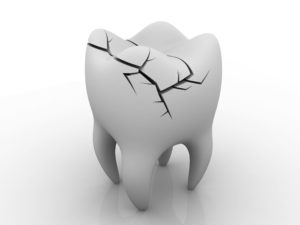 X-rays play an invaluable role in detecting complications with your teeth, such as areas of decay. Unfortunately, there are some issues that may not show up on the images, like tiny cracks. When they are too small to see on an x-ray, it is known as cracked tooth syndrome. The fractures can develop above or below the gum line. No matter where they occur, you will need treatment for cracked tooth syndrome in Tallahassee.
X-rays play an invaluable role in detecting complications with your teeth, such as areas of decay. Unfortunately, there are some issues that may not show up on the images, like tiny cracks. When they are too small to see on an x-ray, it is known as cracked tooth syndrome. The fractures can develop above or below the gum line. No matter where they occur, you will need treatment for cracked tooth syndrome in Tallahassee.
Who’s at Risk of Cracked Tooth Syndrome?
According to the International Journal of Applied & Basic Medical Research, it is estimated 34%-74% of adults have the syndrome, but the exact occurrence remains unknown. While anyone can develop it, it tends to occur most often in females and those between that ages of 30 to 50 years.
There are certain risk factors that increase the likeliness, such as a history of bruxism. The grinding and clenching put a strain on the teeth, causing them to crack under the pressure.
Most often, the cracks appear on the molars because they absorb the most force while chewing; however, it can occur on other teeth as well. A tooth that has a large filling or previously had a root canal is left with a weakened structure. As a result, they are more prone to fractures.
Do I Have Cracked Tooth Syndrome?
It is not unusual for the small cracks to go undiagnosed for some time because they do not always cause symptoms. Over time, there are several signs that may develop, such as:
- Pain when biting or chewing.
- Tooth sensitivity.
- Constant ache.
Do I Need to Have it Treated?
Although the crack may be small now, it is best to have it treated right away. If you do not, it could lead to a large piece of your tooth breaking off, which will mean a trip to your emergency dentist in Tallahassee.
To prevent this, there are several treatments that can be used depending on the severity of the crack. Placing a custom-made dental crown over the tooth will protect it from strain while holding it together to prevent it from breaking further. 20% of cracked teeth will require a root canal in addition to the crown. This will involve removing the inner layer of the tooth, known as the pulp.
If the crack affects the root, there is no way to fix it. The tooth will need to be removed, and you will need a dental prosthetic to fill the space.
Prevent Cracked Tooth Syndrome
You cannot fully avoid it, but there are ways you can help to decrease your risk of cracked tooth syndrome. If you suffer from bruxism, ask your dentist for nightguard.
About , Boyd & Walther Dental Associates
Our team is committed to providing the community with comprehensive dental care. We strive to create individualized solutions to help you reach and maintain a healthy smile. If you have cracked tooth syndrome, we can help. Contact our office today to schedule a consultation.
